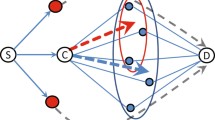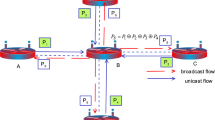Abstract
In this paper, we consider the lifetime maximization routing with network coding in wireless multihop networks. We first show that lifetime maximization with network coding is different from pure routing, throughput maximization with network coding and energy minimization with network coding. Then we formulate lifetime maximization problems in three different cases of (i) no network coding, (ii) two-way network coding, and (iii) overhearing network coding. To solve these problems, we use flow augmenting routing (FA) for the first case, and then extend the FA with network coding (FANC) by using energy minimized one-hop network coding. After that, we investigate the influence of parameters of FANC, evaluate the performance of FANC with two-way and overhearing network coding schemes and compare it with that without network coding under two different power control models, namely, protocol and physical ones. The results show that the lifetime can be improved significantly by using network coding, and the performance gain of network coding decreases with the increase of flow asymmetry and the power control ability.
Similar content being viewed by others
References
Kubisch M, Karl H, Wolisz A, et al. Distributed algorithms for transmission power control in wireless sensor networks. In: Proc IEEE WCNC, New Orleans, 2003. 558–563
Demirkol I, Ersoy C, Alagoz F. MAC protocols for wireless sensor networks: A survey. IEEE Commun Mag, 2006, 44: 115–121
Chang J H, Tassiulas L. Energy conserving routing in wireless ad-hoc networks. In: Proc IEEE INFOCOM, Tel Aviv, 2000. 22–31
Madan R, Lall S. Distributed algorithms for maximum lifetime routing in wireless sensor networks. IEEE Trans Wirel Commun, 2006, 5: 2185–2193
Zussman G, Segall A. Energy efficient routing in ad hoc disaster recovery networks. In: Proc IEEE INFOCOM, San Francisco, 2003. 682–691
Chang H J, Tassiulas L. Maximum lifetime routing in wireless sensor networks. IEEE/ACM Trans Netw, 2004, 12: 609–619
Floréen P, Kaski P, Kohonen J, et al. Lifetime maximization for multicasting in energy-constrained wireless networks. IEEE J Sel Areas Commun, 2005, 23: 117–126
Zhang L, Chen S, Jian Y, et al. Distributed progressive algorithm for maximizing lifetime vector in wireless sensor networks. In: IEEE Proc INFOCOM, Rio de Janeiro, 2009. 2410–2418
Ahlswede R, Cai N, Li S Y R, et al. Network information flow. IEEE Trans Inf Theory, 2000, 46: 1204–1216
Katti S, Rahul H, Hu W, et al. XORs in the air: Practical wireless network coding. IEEE/ACM Trans Netw, 2008, 16: 497–510
Sengupta S, Rayanchu S, Banerjee S. An analysis of wireless network coding for unicast sessions: The case for codingaware routing. In: IEEE Proc INFOCOM, Alaska, 2007. 1028–1036
Khreishah A, Wang C C, Shroff N B. Cross-layer optimization for wireless multihop networks with pairwise intersession network coding. IEEE J Sel Areas Commun, 2009, 27: 606–621
Wu Y, Chou P A, Kung S Y. Minimum-energy multicast in mobile ad hoc networks using network coding. IEEE Trans Commun, 2005, 53: 1906–1918
Cui T, Chen L, Ho T. Energy efficient opportunistic network coding for wireless networks. In: IEEE INFOCOM, Phoenix, 2008. 361–365
Li S Y R, Yeung R W, Cai N. Linear network coding. IEEE Trans Inf Theory, 2003, 49: 371–381
Ho T, Medard M, Koetter R. A random linear network coding approach to multicast. IEEE Trans Inf Theory, 2006, 52: 4413–4430
Wang C C, Shroff N B. Pairwise intersession network coding on directed networks. IEEE Trans Inf Theory, 2010, 56: 3879–3900
Zhang S, Liew S C, Lam P P. Physical-layer network coding. In: Proc IEEE/ACM MOBICOM, Los Angeles, 2006. 23–26
Katti S, Gollakota S, Katabi D. Embracing wireless interference: Analog network coding. In: Proc SIGCOMM, Kyoto, 2007. 397–408
Chachulski S, Jennings M, Katti S, et al. Trading structure for randomness in wireless opportunistic routing. In: Proc SIGCOMM, Kyoto, 2007. 169–180
Ho T, Viswanathan H. Dynamic algorithms for multicast with intra-session network coding. IEEE Trans Inf Theory, 2009, 55: 797–815
Cui T, Chen L, Ho T. Distributed optimization in wireless networks using broadcast advantage. In: 46th IEEE Conference on Decision and Control, New Orleans, 2007. 5839–5844
Lun D S, Ratnakar N, Medard M, et al. Minimum-cost multicast over coded packet networks. IEEE Trans Inf Theory, 2006, 52: 2608–2623
Traskov D, Ratnakar N, Lun D S, et al. Network coding for multiple unicasts: An approach based on linear optimization. In: Proc IEEE ISIT, Seattle, 2006. 1758–1762
Ho T C, Chang Y H, Han K J. On constructive network coding for multiple unicasts. In: 44th Allerton Conference on Communication, Control and Computing, Monticello, 2006. 1–10
Liu J, Goeckel D, Towsley D. Bounds on the throughput gain of network coding in unicast and multicast wireless networks. IEEE Trans JSAC, 2009, 27: 582–592
Haddad A K, Riedi R. Bounds on the benefit of network coding: Throughput and energy saving in wireless networks. In: IEEE Proc INFOCOM, Phoenix, 2008. 376–384
Dutta P, Dawson-haggerty S, Chen Y, et al. Design and evaluation of a versatile and efficient receiver-initiated link layer for low-power wireless. In: SenSys, Zurich, 2010. 136–146
Chaporkar P, Proutiere A. Adaptive network coding and scheduling for maximizing throughput in wireless networks. In: IEEE MobiCom, Quebec, 2007
Le J, Lui J C S, Chiu D M. DCAR: Distributed coding-aware routing in wireless networks. IEEE Trans Mob Comput, 2010, 9: 596–608
Nagajothy M, Radha D. Network lifetime enhancement in wireless sensor network using network coding. In: International Conference on Control, Automation, Communication and Energy Conservation, 2009. 1–4
Hong Y, Xu J, Jiang C. Lifetime maximization in wireless sensor networks with network coding. In: Proc IEEE WiCom, Shanghai, 2007. 2527–2530
Hosseinmardi H, Lahouti F. Multicast lifetime maximization using network coding: A cross-layer approach. In: Proc 24th Biennial Symposium on Communications, 2008. 1–4
Gupta P, Kumar P R. The capacity of wireless networks. IEEE Trans Inf Theory, 2000, 46: 388–404
Brown D, Gallager R. Data Networks. 2nd Ed. New York: Prentice-Hall, 1987
Author information
Authors and Affiliations
Corresponding author
Rights and permissions
About this article
Cite this article
Ding, L., Wu, P., Wang, H. et al. Lifetime maximization routing with network coding in wireless multihop networks. Sci. China Inf. Sci. 56, 1–15 (2013). https://doi.org/10.1007/s11432-012-4778-1
Received:
Accepted:
Published:
Issue Date:
DOI: https://doi.org/10.1007/s11432-012-4778-1




